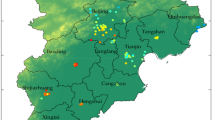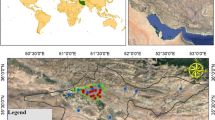Abstract
A better understanding of spatiotemporal distribution of PM2.5 (particulate matter with diameter less than 2.5 micrometer) concentrations in a continuous space-time domain is critical for risk assessment and epidemiologic studies. Existing spatiotemporal interpolation algorithms are usually based on strong assumptions by restricting the interpolation models to the ones with explicit and simple mathematical descriptions, thus neglecting plenty of hidden yet critical influencing factors. In this study, we developed a novel deep-learning-based spatiotemporal interpolation model, which includes the bidirectional Long Short-Term Memory (LSTM) Recurrent Neural Network (RNN) as the main ingredient. Our model is able to take into account both spatial and temporal hidden influencing factors automatically. To the best of our knowledge, it is the first time of applying the bidirectional LSTM RNN in the spatiotemporal interpolation of air pollutants concentrations. We evaluated our novel method using a dataset that contains daily PM2.5 measurements in 2009 over the contiguous southeast region of the USA. Results demonstrate a good performance of our model. We also conducted simulations to explore the properties of spatiotemporal correlations. In particular, we found the temporal correlation is stronger than the spatial correlation.











Similar content being viewed by others
References
Appice A, Ciampi A, Malerba D, Guccione P (2013) Using trend clusters for spatiotemporal interpolation of missing data in a sensor network. Journal of Spatial Information Science 2013:119–153
Arel I, Rose DC, Karnowski TP (2010) Deep machine learning-a new frontier in artificial intelligence research [research frontier]. IEEE Comput Intell Mag 5(4):13–18
Balter BM, Faminskaya MV (2017) Irregularly emitting air pollution sources: acute health risk assessment using aermod and the monte carlo approach to emission rate. Air Qual Atmos Health 10(4):401–409
Bengio Y, LeCun Y (2007) Scaling learning algorithms towards ai. Large-scale kernel machines 34(5):1–41
Bengio Y, Simard P, Frasconi P (1994) Learning long-term dependencies with gradient descent is difficult. IEEE Trans Neural Netw 5(2):157–166
Bengio Y, Courville A, Vincent P (2013) Representation learning: A review and new perspectives. IEEE Trans Pattern Anal Mach Intell 35(8):1798–1828
Chauvin Y, Rumelhart DE (1995) Backpropagation: theory, architectures, and applications. Psychology Press
Chen Y, Shi R, Shu S, Gao W (2013) Ensemble and enhanced PM10 concentration forecast model based on stepwise regression and wavelet analysis. Atmos Environ 74(Supplement C):346–359
Chicco D, Sadowski P, Baldi P (2014) Deep autoencoder neural networks for gene ontology annotation predictions. In: Proceedings of the 5th ACM Conference on Bioinformatics, Computational Biology, and Health Informatics, pp 533–540
Ciregan D, Meier U, Schmidhuber J (2012) Multi-column deep neural networks for image classification. In: 2012 IEEE Conference on Computer Vision and Pattern Recognition (CVPR), pp 3642–3649
De Boor C (1978) A practical guide to splines, vol 27. Springer-Verlag, New York
Devarakonda A, Naumov M, Garland M (2017) Adabatch: adaptive batch sizes for training deep neural networks. arXiv:171202029
Durak BC (2018) Artificial neural networks. https://wiki.tum.de/display/lfdv/Artificial+Neural+Networks, accessed: 2018-03-27
Elkaref M, Bohnet B (2017) A simple lstm model for transition-based dependency parsing. arXiv:170808959
EPA (2016) Air quality system (aqs). available online: http://www3.epa.gov/pm
Fan J, Li Q, Hou J, Feng X, Karimian H, Lin S (2017) A spatiotemporal prediction framework for air pollution based on deep rnn. ISPRS Annals of the Photogrammetry Remote Sensing and Spatial Information Sciences 4:15
Fann N, Risley D (2013) The public health context for pm2.5 and ozone air quality trends. Air Qual Atmos Health 6(1):1–11
Friedman JH, Bentley JL, Finkel RA (1977) An algorithm for finding best matches in logarithmic expected time. ACM Trans Math Softw (TOMS) 3:209–226
Geisser S (1993) Predictive inference. CRC Press, Boca Raton
Gers FA, Schmidhuber E (2001) Lstm recurrent networks learn simple context-free and context-sensitive languages. IEEE Trans Neural Netw 12(6):1333–1340
Goodfellow I, Bengio Y, Courville A (2016) Deep learning. MIT Press, Cambridge
Gräler B, Rehr M, Gerharz L, Pebesma E (2009) Spatio-temporal analysis and interpolation of PM10 measurements in europe for
Hochreiter S, Schmidhuber J (1997) Long short-term memory. Neural Comput 9(8):1735–1780
Ioffe S, Szegedy C (2015) Batch normalization: accelerating deep network training by reducing internal covariate shift. arXiv:1502.03167
Kingma DP, Ba J (2014) Adam: A method for stochastic optimization. arXiv:14126980
Krige DG (1951) A statistical approach to some mine valuations and allied problems at the witwatersrand. Master thesis
Li J, Heap AD (2008) A review of spatial interpolation methods for environmental scientists, vol 137. Geoscience Australia Canberra
Li J, Heap AD (2011) A review of comparative studies of spatial interpolation methods in environmental sciences: Performance and impact factors. Eco Inform 6:228–241
Li L, Revesz P (2004) Interpolation methods for spatio-temporal geographic data. Comput Environ Urban Syst 28:201–227
Li L, Tian J, Zhang X, Holt JB, Piltner R (2012) Estimating population exposure to fine particulate matter in the conterminous us using shape function-based spatiotemporal interpolation method: A county level analysis. GSTF Int J Comput 1:24–30
Li L, Losser T, Yorke C, Piltner R (2014) Fast inverse distance weighting-based spatiotemporal interpolation: A web-based application of interpolating daily fine particulate matter PM2.5 in the contiguous US using parallel programming and k-d tree. Int J Environ Res Public Health 11:9101–9141
Liao D, Peuquet DJ, Duan Y, Whitsel EA, Dou J, Smith RL, Lin HM, Chen JC, Heiss G (2006) Gis approaches for the estimation of residential-level ambient pm concentrations. Environ Health Perspect 114:1374–1380
Losser T, Li L, Piltner R (2014) A spatiotemporal interpolation method using radial basis functions for geospatiotemporal big data. In: COM.geo, pp 17–24
Najafabadi MM, Villanustre F, Khoshgoftaar TM, Seliya N, Wald R, Muharemagic E (2015) Deep learning applications and challenges in big data analytics. J Big Data 2(1):1
Pebesma E (2012) spacetime: Spatio-temporal data in R. J Stat Softw 51:1–30
Qi Z, Wang T, Song G, Hu W, Li X, Zhang ZM (2018) Deep air learning: interpolation, prediction, and feature analysis of fine-grained air quality. IEEE Transactions on Knowledge and Data Engineering
Ross MA (2009) Integrated science assessment for particulate matter. US Environmental Protection Agency, Washington, pp 61–161
Schachter EN, Moshier E, Habre R, Rohr A, Godbold J, Nath A, Grunin A, Coull B, Koutrakis P, Kattan M (2016) Outdoor air pollution and health effects in urban children with moderate to severe asthma. Air Qual Atmos Health 9(3):251–263
Shepard D (1968) A two-dimensional interpolation function for irregularly-spaced data. In: Proceedings of the 23rd ACM national conference, pp 517–524
Srivastava N, Hinton GE, Krizhevsky A, Sutskever I, Salakhutdinov R (2014) Dropout: a simple way to prevent neural networks from overfitting. J Mach Learn Res 15(1):1929–1958
Tobler W R (1970) A computer movie simulating urban growth in the detroit region. Econ Geogr 46:234–240
Tong W, Li L, Zhou X, Franklin J, Besenyi G, Yates H (2017) Learning with spark for the optimal idw-based spatiotemporal interpolation. International Journal of Environmental Research and Public Health (under review)
Van den Oord A, Dieleman S, Schrauwen B (2013) Deep content-based music recommendation. In: Advances in neural information processing systems, pp 2643–2651
Zurflueh EG (1967) Applications of two-dimensional linear wavelength filtering. Geophysics 32:1015–1035
Author information
Authors and Affiliations
Corresponding author
Additional information
Publisher’s Note
Springer Nature remains neutral with regard to jurisdictional claims in published maps and institutional affiliations.
Rights and permissions
About this article
Cite this article
Tong, W., Li, L., Zhou, X. et al. Deep learning PM2.5 concentrations with bidirectional LSTM RNN. Air Qual Atmos Health 12, 411–423 (2019). https://doi.org/10.1007/s11869-018-0647-4
Received:
Accepted:
Published:
Issue Date:
DOI: https://doi.org/10.1007/s11869-018-0647-4




